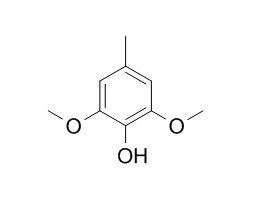Methylsyringol
Methylsyringol is a natural product from Pinus yunnanensis.
Inquire / Order:
manager@chemfaces.com
Technical Inquiries:
service@chemfaces.com
Tel:
+86-27-84237783
Fax:
+86-27-84254680
Address:
1 Building, No. 83, CheCheng Rd., Wuhan Economic and Technological Development Zone, Wuhan, Hubei 430056, PRC
Providing storage is as stated on the product vial and the vial is kept tightly sealed, the product can be stored for up to
24 months(2-8C).
Wherever possible, you should prepare and use solutions on the same day. However, if you need to make up stock solutions in advance, we recommend that you store the solution as aliquots in tightly sealed vials at -20C. Generally, these will be useable for up to two weeks. Before use, and prior to opening the vial we recommend that you allow your product to equilibrate to room temperature for at least 1 hour.
Need more advice on solubility, usage and handling? Please email to: service@chemfaces.com
The packaging of the product may have turned upside down during transportation, resulting in the natural compounds adhering to the neck or cap of the vial. take the vial out of its packaging and gently shake to let the compounds fall to the bottom of the vial. for liquid products, centrifuge at 200-500 RPM to gather the liquid at the bottom of the vial. try to avoid loss or contamination during handling.
J Agric Food Chem.2019, 67(27):7748-7754
Food Sci Biotechnol.2021, 30(2):217-226.
Front Pharmacol.2017, 8:673
Front Plant Sci.2024, 15:1458916.
Front Chem.2023, 11:1245071.
Asian Pac J Cancer Prev.2021, 22(S1):97-106.
Evidence-based Compl.&Alternative Med.2023, 5417813
Dental Journal2024, 57(4): 254-258
Toxicol In Vitro.2022, 81:105346.
Molecules.2021, 26(9):2765.
Related and Featured Products
J Agric Food Chem. 2017 Jul 19;65(28):5681-5689.
Glucosylation of Smoke-Derived Volatiles in Grapevine (Vitis vinifera) is Catalyzed by a Promiscuous Resveratrol/Guaiacol Glucosyltransferase.[Pubmed:
28656763 ]
Vinification of grapes (Vitis vinifera) exposed to forest fire smoke can yield unpalatable wine due to the presence of taint compounds from smoke and the release of smoke derived volatiles from their respective glycosides during the fermentation process or in-mouth during consumption.
METHODS AND RESULTS:
To identify glycosyltransferases (GTs) involved in the formation of glycosidically bound smoke-derived volatiles we performed gene expression analysis of candidate GTs in different grapevine tissues. Second, substrates derived from bushfire smoke or naturally occurring in grapes were screened with the candidate recombinant GTs. A resveratrol GT (UGT72B27) gene, highly expressed in grapevine leaves and berries was identified to be responsible for the production of the phenolic glucosides. UGT72B27 converted the stilbene trans-resveratrol mainly to the 3-O-glucoside.
CONCLUSIONS:
Kinetic analyses yielded specificity constants (kcat/KM) of 114, 17, 9, 8, and 2 mM-1 s-1 for guaiacol, trans-resveratrol, syringol, Methylsyringol, and methylguaiacol, respectively. This knowledge will help to design strategies for managing the risk of producing smoke-affected wines.



